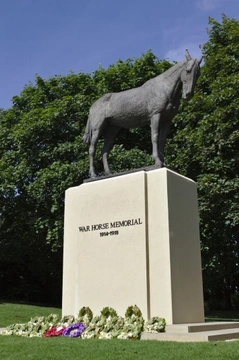
We Will Remember Them
At this time of especially significant remembrance, one hundred years since the end of the First World War, many people have also been thinking back to the contribution made by thousands of horses and other animals in this war to end all wars.
The First World War was perhaps the turning point in the use of the horse in battle; cavalry units gave way to tanks and machine gun batteries against which horses were totally ineffective. However, horses still played an enormous and costly part of this conflict. At the start of the War, it was estimated that the British Army had around 25,000 horses, by the end in 1918 it was thought that around 6 million horses had been on the Western front. Many officers brought their own chargers but people also volunteered their horses from the farm to do their bit in the same way that they offered to give their dogs for national service.
Prior to the war, a census of British horses had been undertaken, identifying how many horses were available and detail gathered about what they ate and what type of work they may be suitable for. The census also listed their nearest train station. During the early weeks of the war, the Army requisitioned over 100,000 horses from civilian owners. If you could not prove that your horse was essential for either agricultural or transport duties then your horse had to be surrendered. There was a certain degree of protest aimed towards the government following which an edict was issued which stated no horse under 15hh would be requisitioned for war duties. The requisitioning of hundreds of horses, their care and ultimately their fate, is all detailed in an exhibition at the National Army Museum in Chelsea in London.
Horses were mainly used at the front for hauling ambulances and artillery and also taking messages as they were quicker than a man on foot struggling through the mud. Conditions were grime and injuries severe. The horse perhaps represents more powerfully than anything else, in his blind acceptance of duty and willing servitude, the total futility of this dreadful conflict.
Of the animals that survived, some officers were able to bring their horses home with them but those that remained were subject to a decision by the British Army to leave them in France and Belgium. Without exception, they all had a pretty horrible fate at continental slaughterhouses, a sad indictment of the powers that be at the time but in light of the number of soldiers whose bodies were never recovered from the mud, perhaps understandable. The fate of horses on their way to European slaughterhouses had already been witnessed just before the war in 1911 by a lady called Ada Cole. Her determination to end this horrible last journey and the evident suffering it caused, sowed the seeds for the international charity we know today as, ‘World Horse Welfare’.
The story of horses in the Great War has been so memorably captured by Michael Morpurgo in his famous book, ‘War Horse’ which was turned into a highly successful stage play featuring the most remarkable life-sized puppetry made from a cane frame and canvas fabric. More recently, War Horse has been developed for the big screen becoming a famous blockbusting film produced by Steven Spielberg.
The Dicken Medal was instituted in 1943 by the People’s Dispensary for Sick Animals, PDSA, to recognise the gallantry and heroism of animals involved in the Second World War. This medal was not awarded retrospectively. The majority of recipients of the medal are therefore either carrier pigeons or dogs, reflecting the thankful absence of the horse from modern warfare by the time of this conflict. There were, however, three horses awarded the medal during the Second World War and these were the police horses, Olga, Upstart and Regal, for their part in patrolling during the bombing raids on London.
Finally, one hundred years after the end of the First World War, the contribution of countless horses, mules and donkeys has been officially recognised by the unveiling of a War Horse Memorial in Ascot in Berkshire. First revealed to the public in June of this year, this life-size bronze horse was created by sculptor, Susan Leyland, and stands on a plinth of Portland stone. It pays tribute to the nobility, courage, unyielding loyalty and immeasurable contribution these animals played in giving us the freedom and democracy we know today. The horse, rather, aptly, is called ‘Poppy’ and the purple poppy has now become the symbol of remembrance for all the animals of war alongside its more famous red cousin.



